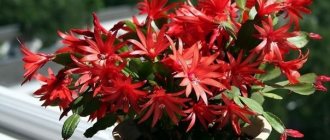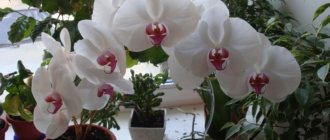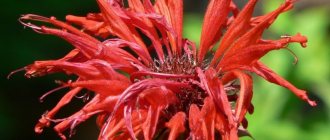How to make Adenium bloom: proper care of the plant before flowering
Adenium is a magnificent flower called the desert rose or Impala lily. In nature, it is a tree that reaches 10 meters in height and grows in desert environments.
Adenium is grown for its caudex and unusual roots, but Adenium is especially beautiful when in bloom. In the home environment, many have been waiting for beautiful Adenium flowers for years. At best, the flower pleases with its caudex and roots, and at worst, it dies due to improper care.
Basic mistakes when caring for a plant
Growing Adenium is not as difficult as it seems, but without certain knowledge the flower may die.
There are nine main mistakes:
- Hypothermia of the flower.
- Overwatering.
- Lack of sufficient sunlight.
- Overfeeding or underfeeding with fertilizers.
- Incorrectly selected soil.
- Incorrectly selected pot.
- Unsettled water.
- Disease.
- Pests.
Adenium, like other plants, needs care appropriate to its type. It is enough to understand that the origin of this plant is desert and if you create the same conditions for your plant, then there will be no problems with it.
What needs to be done for Adenium to bloom
If Adenium does not bloom for a long time, the first thing you need to do is check it for pests and diseases. If the flower is completely healthy and not being damaged, it’s time to pay attention to the soil of the plant and the container in which it is planted.
If you decide to buy soil. Then you should take soil for succulents and cacti, be sure to use baking powder, there are a lot of varieties of both, so as not to make a mistake, it is important to pay attention to the description of the soil.
The soil requirements should be as follows:
- Acidity - ranges from slightly acidic pH - 5.5 to neutral pH - 7.
- Leavening agents - 50%, no more.
- Lightness and looseness - the soil should not be compacted or caked, it should allow water and air to pass through easily.
- Nutritional content - Nitrogen, Potassium, Phosphorus, Magnesium, Boron, Copper, Zinc, Iron, if any element is missing, then it will need to be added after planting or transplanting.
If you decide to prepare the soil yourself, then the “recipe” is as follows: 10% river sand, 25% perlite, 15% vermiculite and 505 gr. soil for succulents. The second “recipe”: 50% of the total peat mixture, vermiculite can be replaced with 20% river sand and 30% plain soil. The soil should be loose and light.
The pot should not be high, but wide in diameter. This is due to the fact that the roots of Adenium grow in width. The bottom of the pot should have wide drainage holes.
A ceramic pot is best suited as it evaporates water well and at the same time allows oxygen to pass through.
But it is worth considering that when it grows, such a pot may burst, and to avoid this, you need to choose a round bowl.
If everything is in order with the soil and the pot, you can proceed to the basic conditions for growing and flowering Adenium:
- Lighting is one of the most important components for flowering. Adenium is one of those plants that is not afraid of the baking sun's rays. It needs to be placed in exactly these places. And also in winter it is additionally illuminated.
- Humidity – Dry air is ideal.
- Temperature - from +25 to +35 C. This temperature should not be changed.
- Permanent place - do not move the plant from one place to another, otherwise the sun's rays may burn the leaves.
Reference! Compliance with all the above conditions is not enough for Adenium to bloom at home.
Many claim that Thai advice is very effective, and it can make a plant bloom.
That is, Adenium is prepared for flowering in two months: it is pruned, shaped, fertilized as needed, and then a period of drought is arranged (for adult plants 2-3 weeks, for young plants one).
After this, water for three days using fertilizers for orchids. After this, they again do a dry period until the first buds appear, after which they water as usual.
The method is good and effective, but it should be remembered that the result will also depend on:
- Proper watering - you should not overwater Adenium, water should not get into the axils of the leaves and on the inflorescences. There should also be no excess water left in the pan.
- Proper fertilizing - fertilizing is done for succulents and cacti during the growing season in spring and summer.
- Pruning - in spring, this will make the tree branchy and bushy and at the same time give lush inflorescences. It is very important to prune Adenium correctly, as this is one of the main requirements for flowering.
- Transplantation is performed once every two to three years, in order to ensure normal root growth and adequate nutrition of the plant and obtain oxygen.
It is important to know what Adenium is grown from: from a seedling or cuttings. If a seedling is expected to bloom first, then flowering should be expected in no less than two years and, moreover, not always according to the expected variety. It also all depends on the type of Adenium and pollination. With Adedium from cuttings, flowering occurs much faster.
So, it is quite possible to wait for the beautiful Adenium to bloom; it is enough to create suitable conditions, proper care and preparation of the plant for flowering, and then it will thank its owners with lush flowers.
Source: https://flowers-j.com/adenium/kak-zastavit-cvesti-adenium/
Description of the plant
The difference between adenium and usual indoor plants is that it looks like a rose and a tree at the same time. Its trunk serves as a storehouse of nutrients and moisture in case of drought, and drought is common in the desert. Only during the rainy season can adenium or desert rose replenish water reserves in its own tissues.
Another unusual phenomenon is that adenium blooms on New Year’s holidays, which can greatly surprise guests.
The adenium caudex is a thickening at the bottom of the trunk, essentially a root. Caudex, although located on the surface of the earth, does not participate in the process of photosynthesis. It is believed that the caudex should be located underground so as not to overheat and evaporate water, but succulent breeders expose it to the surface. After all, the thick trunk is the most remarkable thing about this flower.
The second advantage is the bright large flowers of adenium of regular or double shape, similar to rose blooms. Because of this, the plant received its second name - desert rose. The succulent has few leaves; they are elongated with a rounded tip, although they can vary depending on the varietal of the crop.
Many gardeners, having heard about the topical origin of adenium, refuse to grow and care for it at home, because all species are extremely demanding on the climate. But there is good news: selection does not stand still and new varieties have already been created that feel good in the middle zone.
They need watering and tolerate working radiators in the winter. Therefore, you can take on the cultivation of adenium with peace of mind. Even if you grow it from seeds, its growth will be noticeable day after day, and flowering can occur within a year.
Growing conditions in the wild
Wild relatives of adenium are not spoiled with care. Moreover, they grow under the scorching sun, with a minimum of nutrients and water. Most of the caudex is located underground, the roots are strongly intertwined, forming complex patterns.
Wild adenium has almost no leaves. This is due to the lack of nitrogen in sandy soil and the almost complete absence of organic matter. At home, you can achieve a beautiful combination of greenery and flowering thanks to regular fertilizing.
Interesting! Flower growers consider the benefits of fertilizer for adenium from the position of “how to make the caudex thick”
And even all care comes down to how to achieve thickening of the caudex.
Adenium obese care at home, transplanting and pruning
The Adenium plant is a representative of the Kutrovaceae family. His homeland is Saudi Arabia. Translated from some languages, it is called adenium desert rose.
Adenium flower is a compact tree with a fleshy trunk, grows rather slowly, the main half of the thickened trunk is above the ground. The shoots of adenium are branched, and the leaves are elongated with a glossy appearance and a slightly pointed and rounded end.
Adenium inflorescences are distinguished by their individuality and beautiful appearance; they are large in size and have an interesting shade ranging from light to rich crimson. The inside of the flower is a lighter shade.
It should be noted that when pruned, adenium releases a toxic substance; after working with the flower, you must wash your hands well.
Adenium types and varieties
The adenium family represents approximately five species, and all the rest are subspecies.
Adenium obesum or another name is adenium obese . The plant develops slowly, its trunk is woody, and significant branching begins in the upper part.
The height of the plant is approximately 1.5 meters, and the diameter of the trunk exceeds the mark of more than a meter. Grayish shoots with a thick fleshy base.
Light green leaves with a long base grow on the upper shoots, reaching a length of about 10 cm.
In summer, the plant is about 5 cm in diameter with bright pink, red or light petals. Growing this plant at home, its height can reach about 70 cm, it all depends on the conditions of care and the abundance of moisture. Some tribes used its poison to create poisonous arrowheads.
Adenium arabicum natural habitat is the south of the Arabian Peninsula. It is worth noting an interesting fact: if the plant does not have enough water, then the adenium remains in the form of a bush with a large root system. And if there is enough water, the plant develops and becomes a tree.
The leaves of this plant are outwardly shiny and larger in size than those of the obsessum, and with age they become up to 20 cm long and about 11 cm wide. The trunk reaches up to one meter in diameter. Adenium arabicum grows well at home and is a fairly unpretentious plant.
Flowering begins in the third year after planting. The first inflorescences begin to appear in the second half of winter. The most striking feature of Adenium arabicum is its caudex, which is its appearance and expanded base.
Adenium mini
This is the brightest representative among other species. It is an actively branching bush, which blooms unusually and very actively from the moment of planting. Its growth is slow, like all species. The peculiarity that the plant has is its inconsistent varietal characteristics after breeding work, differences in color and shape.
Adenium multiflora is native to the coast of Mozambique. This species forms various interesting hybrids with Adenium obsumum.
This plant is a shrub, its identity is its rhizome, but by the fifth year of growth it disappears. Flowering in this species occurs in cold and dry times, in winter. The inflorescences are white with a red edge.
There are also red, burgundy and pink shades with inflorescences up to 7 cm in diameter.
Adenium care at home
Caring for adenium does not take much time and effort, so the plant is quite popular among gardeners.
Adenium is a heat-loving plant that develops well even when exposed to sunlight. Sufficient lighting is a necessity for adenium in care and maintenance, so the south side is what it needs. The plant on the windowsill must be constantly turned around so that it grows evenly and does not “crook the top.”
For adenium at home, it is necessary to maintain a temperature of 24 to 35 degrees; this is necessary during active development from autumn to spring. Moisturizing does not play a big role; you can sometimes spray it in the summer and only the leaves, do not touch the flowers.
In the autumn, when the sunny day shortens for adenium, a state of dormancy begins. In some varieties, some of the leaves fall off, and sometimes all of them. In winter, adenium can withstand temperature drops of up to 10 degrees, but it is important not to overwater the plant during this period, otherwise you risk losing the plant due to fungal infection.
Adenium watering
Watering in spring and summer, when active development takes place, needs to be moistened regularly and abundantly. In winter, watering is reduced and moistened as necessary when the soil cover dries out. Water for irrigation needs to be soft, at room temperature and slightly sour.
Adenium blooms from spring to autumn. The inflorescences are large and bloom in large numbers. Bouquets of flowers are located at the ends of the branches.
Adenium transplant
For adenium, transplantation is carried out as needed, but in good conditions adenium can develop quite quickly. The first transplant is required at about three months of age.
The thickness of the shoots usually reaches one centimeter. Adenium is transplanted in the evening or in cloudy weather and is not moistened for several days. If it turns out that the transplant happened during daylight hours, then after transplanting the plant must be moistened.
How to transplant adenium
The plant is taken out of the container and inspected for the presence of putrefactive formations. At the bottom of the new container, add drainage and a small amount of soil and place the seedling there, sprinkle the soil and make sure that it replaces the void between the roots. After transplantation, the plant is placed in a dark place for a couple of days. Young plants prefer moderate watering.
Soil for adenium
For adenium, the soil for transplantation is of particular importance. The ideal soil for adenium is light and moisture-permeable, with a sufficient amount of fertilizer and a neutral or acidic reaction.
You can purchase ready-made soil and add perlite or vermiculite to it, but ensure that its amount does not exceed 20%. You can buy ready-made soil for terrestrial orchids. You can also prepare the soil yourself. The composition of such soil for adenium should include coconut fiber or peat, deciduous soil or humus, coarse sand, perlite, and the ratio (5: 2: 1: 2).
Why doesn't adenium bloom?
Due to improper maintenance conditions, sometimes adenium stops flowering. The reason may be a large amount of fertilizer, because of this the flower goes well into the foliage, but does not bloom. Also, there may be a lack of sunlight, rotting of the root system and abundant watering in the cold season and improper observance of a dormant state for adenium.
Therefore, in order to make the plant bloom at home, you must follow these care rules.
Adenium from seeds at home
The process of growing adenium from seeds takes place in stages:
Before sowing, the seeds are soaked for several hours in warm water, adding a growth stimulator to it. To successfully grow adenium from seeds at home, you need to properly prepare the soil.
The composition of the soil is peat for succulents with a soil loosener, one to one. Coarse sand or perlite, fine charcoal or expanded clay can serve as a ripper. If there is no peat, take coconut fiber.
Before planting adenium seeds in the ground, you need to choose a container; it is better to give preference to small pots with holes or disposable cups. At the bottom we arrange drainage from brick chips, small pieces of polystyrene foam or charcoal, and at the end there is soil.
We plant the seeds on top of the ground and press them gently into the ground. Cover them with cling film or you can use a cut plastic bottle to cover them. Moistening of adenium seeds must be done moderately from a spray bottle.
The temperature must be maintained at about 25 degrees, periodically ventilating your seeds. After the adenium seedlings have germinated, they are placed in a fairly well-lit, warm room so that they begin to actively develop. The timing of germination may vary depending on the variety, but in about a few weeks.
Caring for adenium seedlings
When the seedlings grow several leaves, they should be replanted. In adenium, seedlings need to be transplanted after germination about three times during the year, as they grow. Adenium planted from seeds begins to bloom after a couple of years. Caring for seedlings, like all plants.
When to feed adenium seedlings
It is necessary to feed once a month with mineral and organic liquid fertilizers. This must be done during active growth and during flowering. To achieve lush leaves, you need to apply fertilizer with nitrogen at the beginning of spring. Flowering time can be extended by adding phosphorus or potassium.
Trimming adenium at home
To form the roots of the adenium, the so-called caudex, you need to lift it a little with each replanting. But not too high above the ground, as this can stop its development.
You can form adenium at home. In adenium, crown formation is not always the final result that you expected. To do this, you need to be patient. Young individuals are simply pinched, and a trunk is formed from adult adeniums using pruning.
How to prune adenium correctly
Pruning of adenium means that the larger the diameter of the shoots, the larger the cutting area needs to be, and this promises many new stems at the cut site. Form a crown pruning for adenium, as you would like to see your plant in your interior.
It should also be taken into account that if adenium is cut too low, the plant will grow irregular thin stems. The best period for pruning is the beginning of active growth. New branches appear at the cut site within a month and a half.
For adenium, root pruning is a real art. Proper root formation will give your plant an exotic look. Root pruning must be done on mature plants.
There are many interesting formations. One of these is when adenium is planted on a round plate, thanks to which the root system grows to the sides like an octopus.
The roots must be secured in the required position using sticks or toothpicks.
Diseases and pests of adenium
Adeniums are rarely susceptible to diseases; this may be caused by failure to comply with the conditions for caring for the plant.
Adenium is dropping leaves, what to do - most likely the reason is insufficient lighting. Due to lack of sunlight, adenium leaves turn yellow and fall off. If this happens in winter, try to provide artificial lighting. Also, the cause may be a lack of nitrogen; you should feed it with fertilizer containing nitrogen.
Adenium leaves curl or leaves do not grow , the reason is a lack of phosphorus fertilizer.
Pests of adenium are mealyworms and spider mites . An insecticidal solution is used as treatment.
By following all the instructions, your plant will delight you with its growth and flowering!
Source: https://chvetochki.ru/adenium/
Roots
Go ahead. Let's check the caudex. Is your pet's hair hard as a rock? Great, that's exactly how it should be. Is it really soft? Or is it springy? In this case, you need to figure out the reason. Perhaps you have come across a slow-witted plant that does not grow suction roots well. As a result, adenium's water balance is disturbed and it is dehydrated. One of the possible rehabilitation options is to place it in perlite with wick watering for a while. Another cause of soft caudex is somewhat worse. You overwater the adenium and its roots rot. Remove the adenium from the pot and inspect the root system. If there are rotten roots, then work as a surgeon. Remove, dry, and after replanting, adjust the watering regime. Along the way, you will be able to exclude the presence of an invisible enemy of all colors - the root worm, which quietly sucks all the juices out of the plant and poisons its normal functioning.
Why Adenium may not bloom: reasons, how to fight it, how to make it bloom
Adenium is one of the flowers that are becoming increasingly popular among gardeners. It has a rather unusual appearance, which is why it attracts the attention of many people.
Adenium, when it begins to bloom, literally amazes with its beauty. However, this phenomenon is not always possible, and not all owners see beautiful flowers.
Why adenium does not bloom and what to do to make the plant please with its beautiful appearance will be described in detail below.
When does adenium bloom?
The second name of adenium is “Stone Rose”. The plant blooms with beautiful flowers that resemble gramophones. When adenium blooms is a question that interests many people. An adult plant begins to produce buds for the first time in spring - from the end of March. The second flowering occurs in autumn - early September.
Adenium amazes with its abundant flowering
Also, beginning flower growers often have a question about how long adenium grows before the first flowering. If the crop was propagated using cuttings, it will bloom much earlier than a plant grown from seeds.
Adenium from seeds in most cases begins to produce buds for the first time in the 3rd or 4th year.
However, in some species, flowers may begin to appear at the age of two years, although not in such numbers as in a more mature flower.
Attention! If the plant is already about 5 years old and has never bloomed, then there is some cause for concern.
What factors influence the flowering of adenium
Kalanchoe blooming: care at home and reasons why it does not bloom
The flowering of the crop may stop if the necessary care rules are not followed. If the plant is quite mature, then it is important to determine the reason why adenium does not bloom at home.
Adenium varieties differ in flowers, but all are beautiful
Air humidity
For adenium, high air humidity at home is unfavorable. The plant is a succulent, so it can easily tolerate a slight drought. With increased humidity, the internal parts of the buds dry out, they wither and crumble. As a result, flowering does not occur.
However, during periods of active growth and in extreme heat, it is recommended to regularly spray the crop with warm water from a spray bottle. The procedure is carried out early in the morning or in the evening, so that after it the sun’s rays do not fall on the leaves.
Attention! If flowers appear on the plant, then you need to spray very carefully, avoiding water getting on the petals, or better yet, stop altogether.
Temperature
In the warm season, the plant easily tolerates temperatures of +35 degrees, because its homeland is Saudi Arabia. However, Adenium obesum, as it is called in Latin, does not like drafts at all.
In winter, it is important to properly provide the crop with a period of rest. This determines whether the plant will bloom next season. With the arrival of winter, the flower almost completely gets rid of its leaves and goes into a state of “torpor.” In order to properly prepare adenium for wintering, gradually reduce watering, and after a while stop it completely.
In winter, the flower pot is placed in a dark room with good ventilation; the air temperature should be in the range from +10 to +15 degrees. With completely dry soil in the container, the crop can remain in normal condition even at +4 degrees, but it is better not to test the capabilities of the flower.
With the onset of spring, the pot is moved to a bright place with a higher temperature.
The flowers are very similar to gramophones
Watering
In winter, watering of adenium is carried out once a month, or even less often. With the onset of spring, the amount of irrigation is gradually increased, while reducing the interval between waterings.
To water adenium, use soft and warm water, slightly sour. It is impossible to allow the soil to dry out completely during the warm period, otherwise the flower will simply stop growing.
For reference! During the flowering period, dry soil causes the buds to drop or not fully open.
However, excess moisture also negatively affects the condition of the crop. Rotting of the root system cannot be ruled out, especially from frequent irrigation at low temperatures.
Rest period
If we talk about indoor adenium, flowering may not occur this year if the plant was not allowed to rest in the past.
The dormant period occurs in the winter season. There is no need to feed the flower for three months, and watering should be reduced to a minimum. It is advisable to place the pot in the shade, choose a cool room.
Diseases and pests are a common reason for failure to bloom.
Often adenium does not want to bloom due to pest damage or the presence of any diseases.
Why cyclamen does not bloom: the main reasons and methods of resuscitation
Excessive watering in cold weather often causes rotting of the root system and caudex (the thick lower part of the trunk). The plant becomes weak, withers, and leaves fall off. The disease gradually spreads throughout the flower.
https://www.youtube.com/watch?v=5Ar44NAXUkQ
In this case, it will not be possible to wait for buds; here it is already important to save the culture from complete destruction. To do this, the affected part is cut off, the remainder is treated with special fungicidal agents, dried and planted in another soil. Water very carefully, and then after some time rooting will occur.
Adenium can be affected by pests such as mealybugs and spider mites. If the damage is not noticed in time, the plant gradually loses strength, does not throw out flower buds and does not bloom. It is important to constantly inspect the lower parts of the leaves to immediately notice the presence of parasites.
For reference! You can get rid of harmful insects using various specialized preparations that can be purchased in stores.
The solution prepared according to the instructions is used to treat the flower and, if necessary, the soil in the pot. With timely measures taken, adenium can be saved. It is recommended that after getting rid of parasites, you do not try to stimulate flowering immediately, but give the crop a little rest.
How to stimulate flowering
Why the orchid does not bloom: the main reasons and methods of dealing with them
Of course, every gardener wants to make a succulent bloom, because it is truly a beautiful sight. To stimulate adenium to flower, it is recommended to adhere to the following rules:
- provide the plant with the correct rest period in winter;
- maintain low humidity in the room;
- provide the plant with sufficient lighting, add additional lamps if necessary;
- monitor the quality of the soil, replace it if it is too acidic;
- fertilize in a timely manner with special products suitable for succulents;
- If necessary, prune the plant.
Feeding the plant causes new shoots to appear, but it is worth remembering that excess nitrogen will lead to the appearance of new green leaves, but buds will not form. Therefore, it is important to choose the right fertilizers.
Timely pruning and pinching of the plant will allow you to form a beautiful crown. In addition, the plant will not spend all its energy on developing shoots and will be able to produce buds and bloom.
The lack of flowering in adenium can be caused by various reasons. In most cases, improper care, the development of diseases, and damage by harmful insects are to blame. It is important to try to determine the reason why the plant does not bloom, eliminate it and know what to do to make the adenium bloom. With proper care, the crop will delight you with its excellent appearance and beautiful flowering.
Source: https://pocvetam.ru/komnatnye-rasteniya/pochemu-ne-tsvetet-adenium.html
Diseases and pests are a common reason for failure to bloom.
Most often, adenium is affected by rot and fungus, which are the result of improper watering. Both diseases begin, first of all, to damage the caudex, which stops not only flowering, but the development of the bush as a whole: the leaves turn yellow, the buds fall off without having time to form normally.
To get rid of this problem, it is necessary to treat the plant with fungicides, and cut off the affected areas and sprinkle with activated carbon.
Among the pests that prevent the tree from developing normally are spider mites, mealybugs and scale insects. Insects attack the soft and succulent parts of the bush, including the peduncle. Weakened adenium cannot grow normally and form inflorescences. Some pests are not noticeable on the surface of the bush, as they are small in size or hide on the back side of the leaf. Many of them are securely located in the axils of the leaves.
In the fight against pests it is necessary to use insecticides. Spider mites are destroyed with acaricides. During treatment, you need to thoroughly water the soil with the solution, since insect larvae are found in the soil among the roots.
Important! After treating the bush, you need to let it rest for about a month.
To make adenium bloom, you need to carry out the necessary care measures in a timely manner.
Is it possible to achieve this process at home?
The flowering of adenium is influenced by several factors:
- Rest period.
- Correctness and regularity of pruning.
- Watering.
- Lighting.
These points must be included in the rules for caring for the plant, and then adenium will bloom in your home.
What to do: detailed instructions
The most favorable conditions for adenium flowering are greenhouses or greenhouses. But you can achieve flowering at home, for which you need to strictly follow the rules of caring for it. Let's look at them in more detail.
- To ensure a good supply of nutrients to the flower, you need to place the plant in loose soil (broken brick, crushed charcoal, etc. can be used as a loosening agent) with an acidity of 6.5-7.8 pH.
Young flowers are replanted once a year, and adult plants once every three years. To do this, the plant must be carefully removed from the pot, damaged roots and stems removed, and drainage and pre-prepared soil poured into a new pot. When transplanting, you should carefully fill the empty space between the roots.
- Adenium is best planted in small pots. Because it will not bloom until it has entwined its roots around the entire volume of the earth.
Quiet time: autumn, winter
- In autumn, adenium begins a dormant period, so starting from mid-September it needs to be kept cool (temperature should not exceed 20 °C), while simultaneously reducing the level of humidity and light, and the frequency of watering should be reduced. At this time, the leaves fall off.
- Winter is a dormant period for the flower; at this time it requires rare watering. Adenium needs to be watered once a month, moistening only the surface of the soil. A comfortable temperature for it during this period is 12-16°C; it is advisable to move the flower to a shaded place. Feeding during this period is completely excluded.
Spring
- With the arrival of spring, when the growing point begins to swell, the frequency of watering should begin to be increased, but this must be done gradually.
- Before flowering, when adenium begins to awaken, its shoots are cut off. In this way, the crown of the plant is formed and favorable conditions are created for the formation of buds.
Adeniums are not pruned too low. This leads to weakening of the stems and disruption of the shape of the crown.
The concentration of phosphorus and calcium in the solution ready for fertilizer should not exceed 2%.
During the summer period, a comfortable temperature for adeniums is considered to be 25-27°C. You should regularly take the flower out into the fresh air and be sure to expose it to direct sunlight for 4-5 hours. To avoid burning the leaves, the rest of the time you need to shade the flower a little. Light shading can be provided by other flowers or a translucent curtain.











